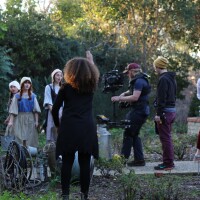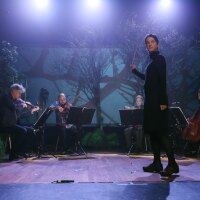An Insider's Guide to the Symbols of 'Vireo'

Vireo, the groundbreaking made-for-TV opera, is now available for streaming. Watch the 12 full episodes and dive into the world of Vireo through librettos, essays and production notes. Find more bonus content on KCET.org and LinkTV.org.
"Vireo: The Spiritual Biography of a Witch's Accuser" is the story of a teenage girl who hears voices and has fits, leading to a tragic string of events. The woman accused of witchcraft is killed. Vireo herself is poked, prodded and analyzed. She becomes the subject of study. All the while, her voice growing to try and overpower those who make judgments about her condition.
Vireo, the character, exists in multiple centuries and her story brings attention to the treatment of young women throughout history. Initially inspired by composer Lisa Bielawa's senior essay on the same subject, "Vireo" explores this phenomenon through song and symbols. Below, we take a look at seven symbols inside "Vireo."
1. The Witch
The Witch is burned within the first half-hour of "Vireo," but her presence lasts throughout the opera. She goes from being the woman accused of sorcery by the story's teenage protagonist, to the figure that haunts Vireo. She is a reminder of how women have been vilified, blamed for strange occurrences, accused of witchcraft and executed. She is also a symbol of how women have been coerced to turn on each other to try and save themselves.

2. The Student
Raphael is a student observing the Doctor as he observes Vireo. He falls for the teenager and uses her essentially as a muse for his work. In a video interviewwith KCET, Bielawa talks about the research she had done as a college student that led to "Vireo." For her senior essay, she looked at work written by men about teenage women. During the course of her research, she found that men ranging from doctors to artists were on some level studying the actions of young women, but, as she noted in the interview, the voice of the women were left out of these documents. As a student looking to Vireo as he works on his own thesis, Raphael becomes the embodiment of that research. Tenor Ryan Glover noted in a previous interview with KCET, "I believe he loves what she represents, not necessarily her as an actual person."

3. The Cow
The Cow, like The Witch, dies quickly, but her presence remains. Bielawa recalls how librettist Erik Ehn referred to "the ghostly simulacrum of the cow." She adds, "To me that's so evocative. What happens to somebody musically, in an opera, if they sing after they're dead? That's amazing."
Bielawa also notes that the Cow and the Witch have a duet. "Both of them are dead," she says. "Coming up with a musical language, the melodies of dead people, that was something that really got me going. I don't know exactly how to describe it."
Ultimately, the Cow comes to represent a sort of sad reality. She gives parts of herself with her milk, but that's not enough. Ultimately, its her flesh that becomes food. Director Charlie Otte mentioned the "dark comedy" of the chapter concerning the Cow's demise. "I want it to be funny and at the same time, she's very tragic," he says. "We're trying to capture all those things at once." This extended to the Cow's costume, which includes a spotted cape and a crown made of a cow skull. "She stands very straight. She's very regal. She has a sense of power," he says. "At the same time, she picks up a piece of cheese and sings about wanting to offer us her cheese and her milk and then she pops the cheese in her mouth herself and eats it."

4. The Car
Bielawa let us in on the symbolism of the car scene in episode ten, "Ice on the Sargasso," where Vireo and Caroline switch off as drivers: it's a power struggle told through the way they sing in relation to the hurdy-gurdy that accompanies them. "Whichever one of the girls was in control be on the top," she says. "So then, whichever girl was not in the more powerful position, she would go underneath and the hurdy-gurdy would go above her."
She adds, "Who knows if people can hear that? Some people will analyze that. I think the result emotionally is to be felt because the singers who are singers, you hear them lower than the instrument, whoever is in control is soaring above that."

5. The Circus
As "Vireo" veers towards its conclusion, the protagonist is taken to a medical convention in Sweden where the Doctor will present his findings on her condition. However, to Vireo and the audience, this scene unfolds like a circus. "We essentially jump into her point of view and her point of view now sees this operating amphitheater of doctors as a circus amphitheater filled with performers and clowns and animals and all of her friends from school," says director Charlie Otte. "It's a transformation that puts us with her now. Rather than observing her, we are with her, observing this crazy circus."

6. The Queen of Sweden
During the medical convention/circus, the Queen of Sweden appears. "She's managed to wrap the whole thing up for us as a way of acknowledging the 20th century's impact and change that occurs when people try to change how they look at this study of hysteria," says Otte.
The director of "Vireo" explains that, with World War I, a lot of the research that had been put into studying female hysteria ceased due to the devastation of Europe and the needs of the people who survived the war. "All of a sudden, there was now a new disease, which was what they called shell shock at the time," he says. "People came away from war with a different set of wounds and things than they had in previous wars. All of this focus that had been put onto studying hysteria changed. Essentially, they all stopped." The appearance of the Queen of Sweden, then, marks these changes.

7. The Audience
At various different points in time during "Vireo," we'll see a glimpse of an audience. "We always liked the idea that there's a certain performative quality to this thing," says Otte. "We're not pretending that it's not an opera. There are musicians there. There are people singing there. I like the idea that there are these observers. In almost every episode, there are people there who are just watching."
But, the audience isn't there just to remind viewers that this is an opera. They also point to the treatment of Vireo throughout the story. "There is that sense that she's always under observation," says Otte. "She's always part of a world that is studying her, not only the Doctor but everybody else."

Top image: David Soderlund


